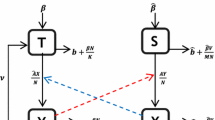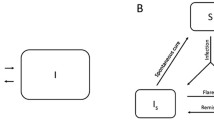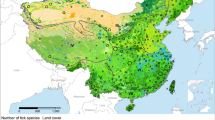Abstract
The paper considers the problem of estimating the risk of a tick-borne disease in a given region. A large set of epidemiological data is evaluated, including the point pattern of collected cases, the population map and covariates, i.e. explanatory variables of geographical nature, obtained from GIS.
The methodology covers the choice of those covariates which influence the risk of infection most. Generalized linear models are used and AIC criterion yields the decision. Further, an empirical Bayesian approach is used to estimate the parameters of the risk model. Statistical properties of the estimators are investigated. Finally, a comparison with earlier results is discussed from the point of view of statistical disease mapping.
Similar content being viewed by others
References
N. G. Best, K. Ickstadt, and R. L. Wolpert Spatial Poisson regression for health and exposure data measured at disparate resolutions. Journal of the American Statistical Association 95 (2000), 1076–1088.
J. F. Bithell: An application of density estimation to geographical epidemiology. Statistics in Medicine 9 (1980), 691–701.
P. Diggle: Overview of statistical methods for disease mapping and its relationship to cluster detection. In: Spatial Epidemiology: Methods and Applications (P. Elliott et al., eds.). Oxford University Press, Oxford, 2000, pp. 87–103.
M. Mašta: Assessment of risk of infection by means of a Bayesian method. In: Proceedings S4G International Conference on Stereology, Spatial Statistics and Stochastic Geometry (V. Beneš, J. Janáček, and I. Saxl, eds.). JČMF, Praha, 1999, pp. 197–202.
P. McCullagh, J. A. Nelder: Generalized Linear Models. Chapman & Hall, London, 1992, pp. 26–43, 193–200.
A. Mollie, S. Richardson: Empirical Bayes estimates of cancer mortality rates using spatial models. Statistics in Medicine 10 (1991), 95–112.
S. H. Stern, N. Cressie: Inference for extremes in disease mapping. Methods of Disease Mapping and Risk Assessment for Public Health Decision Making (A. Lawson et al., eds.). Wiley, New York, 1999, pp. 63–84.
W. N. Venables, B. D. Ripley: Modern Applied Statistics with S-PLUS. Springer, New York, 1997, pp. 242–243.
P. Zeman: Objective assessment of risk maps of tick-borne encephalitis and lyme borreliosis based on spatial patterns of located cases.International Journal of Epidemiology 26 (1997), 1121–1130.
Author information
Authors and Affiliations
Rights and permissions
About this article
Cite this article
Jiruše, M., Machek, J., Beneš, V. et al. A Bayesian Estimate of the Risk of Tick-Borne Diseases. Applications of Mathematics 49, 389–404 (2004). https://doi.org/10.1023/B:APOM.0000048119.55855.65
Issue Date:
DOI: https://doi.org/10.1023/B:APOM.0000048119.55855.65




